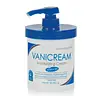What's inside
What's inside
 Key Ingredients
Key Ingredients

 Benefits
Benefits

 Concerns
Concerns

 Ingredients Side-by-side
Ingredients Side-by-side

Water
Skin ConditioningGlycerin
HumectantIsopropyl Palmitate
EmollientParaffinum Liquidum
EmollientEthylhexyl Isononanoate
EmollientButyrospermum Parkii Butter
Skin ConditioningCetearyl Alcohol
EmollientC12-15 Alkyl Benzoate
AntimicrobialPetrolatum
EmollientTrisiloxane
Skin ConditioningBehenamidopropyl Dimethylamine
EmulsifyingCetyl-Pg Hydroxyethyl Palmitamide
Skin ConditioningParaffin
PerfumingBehentrimonium Chloride
PreservativeAllantoin
Skin ConditioningPanthenol
Skin ConditioningEthylene/Propylene/Styrene Copolymer
Butylene Glycol
HumectantDimethicone
EmollientLactic Acid
BufferingBenzalkonium Chloride
AntimicrobialButylene/Ethylene/Styrene Copolymer
Polyquaternium-37
Isopropyl Alcohol
SolventCitrus Aurantium Dulcis Peel Oil
MaskingEucalyptus Globulus Leaf Extract
PerfumingSodium Lauroyl Lactylate
EmulsifyingCeramide NP
Skin ConditioningCeramide AP
Skin ConditioningCholesterol
EmollientPhytosphingosine
Skin ConditioningCarbomer
Emulsion StabilisingXanthan Gum
EmulsifyingCeramide EOP
Skin ConditioningMethylparaben
PreservativeEthylparaben
PreservativeLimonene
PerfumingWater, Glycerin, Isopropyl Palmitate, Paraffinum Liquidum, Ethylhexyl Isononanoate, Butyrospermum Parkii Butter, Cetearyl Alcohol, C12-15 Alkyl Benzoate, Petrolatum, Trisiloxane, Behenamidopropyl Dimethylamine, Cetyl-Pg Hydroxyethyl Palmitamide, Paraffin, Behentrimonium Chloride, Allantoin, Panthenol, Ethylene/Propylene/Styrene Copolymer, Butylene Glycol, Dimethicone, Lactic Acid, Benzalkonium Chloride, Butylene/Ethylene/Styrene Copolymer, Polyquaternium-37, Isopropyl Alcohol, Citrus Aurantium Dulcis Peel Oil, Eucalyptus Globulus Leaf Extract, Sodium Lauroyl Lactylate, Ceramide NP, Ceramide AP, Cholesterol, Phytosphingosine, Carbomer, Xanthan Gum, Ceramide EOP, Methylparaben, Ethylparaben, Limonene
 Reviews
Reviews

Ingredients Explained
These ingredients are found in both products.
Ingredients higher up in an ingredient list are typically present in a larger amount.
Cetearyl alcohol is a mixture of two fatty alcohols: cetyl alcohol and stearyl alcohol. It is mainly used as an emulsifier. Emulsifiers help prevent the separation of oils and products. Due to its composition, it can also be used to thicken a product or help create foam.
Cetearyl alcohol is an emollient. Emollients help soothe and hydrate the skin by trapping moisture.
Studies show Cetearyl alcohol is non-toxic and non-irritating. The FDA allows products labeled "alcohol-free" to have fatty alcohols.
This ingredient is usually derived from plant oils such as palm, vegetable, or coconut oils. There is debate on whether this ingredient will cause acne.
Due to the fatty acid base, this ingredient may not be Malassezia folliculitis safe.
Learn more about Cetearyl AlcoholPetrolatum is more commonly known as petroleum jelly. It is created by mixing waxes and mineral oils.
This ingredient is effective at reducing water loss by 99%. This is because it is an occlusive. Occlusives create a hydrophobic barrier on the skin to prevent evaporation. This property makes it great for hydrating dry skin.
Pro tip: Use occlusives, such as this ingredient, on damp skin for the best results.
The quality or origin of petrolatum is only known when disclosed by the brand. Most cosmetic petrolatum has gone through several purification stages.
Another benefit of occlusives is it protects your skin against infection or allergies.
Petrolatum may not be safe for fungal-acne. Studies show mineral oil / petroleum leads to the growth of M. Furfur, a type of yeast.
Learn more about PetrolatumWater. It's the most common cosmetic ingredient of all. You'll usually see it at the top of ingredient lists, meaning that it makes up the largest part of the product.
So why is it so popular? Water most often acts as a solvent - this means that it helps dissolve other ingredients into the formulation.
You'll also recognize water as that liquid we all need to stay alive. If you see this, drink a glass of water. Stay hydrated!
Learn more about Water